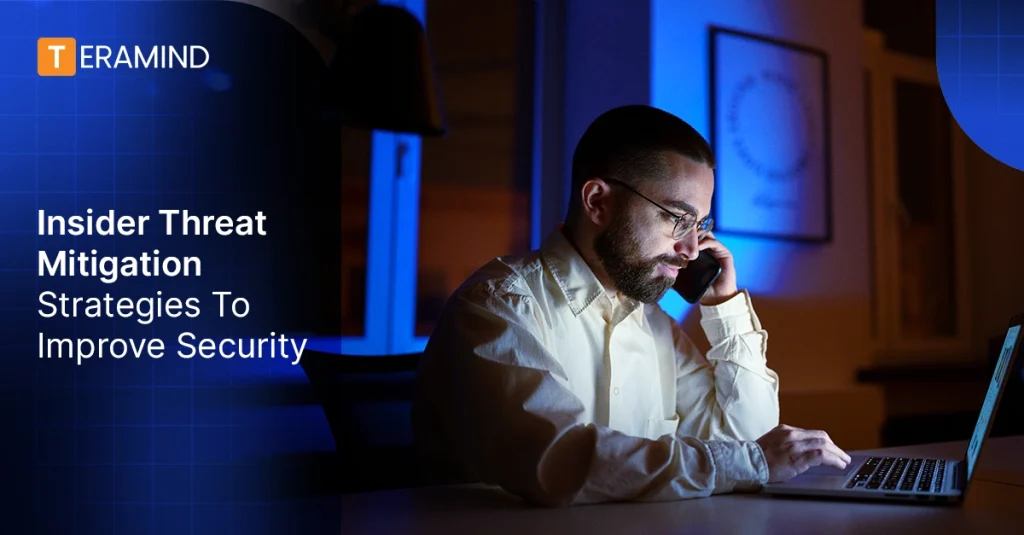When company leaders and managers consider their cybersecurity risks, they too often focus on their vulnerability to external threats only. While state-sponsored attacks, phishing attacks, ransomware, and third-party software infiltration are becoming more prevalent in the current threat landscape, it’s important that those potentialities don’t distract attention from the dangers posed by insider threats.
Without the right internal measures to protect you, your company’s most valuable data and intellectual property could fall into the hands of a malicious insider.
And their harmful actions could put your clients, your reputation, and your company finances at major risk: According to IBM research, the global average cost of a data breach was $4.45 million in 2023. In this article, we’ll explore the best practices for insider threat mitigation you need to implement if you’re ready to make internal security a bigger priority this year.
What Is Insider Threat Mitigation?
Insider threat mitigation comprises the security policies, protocols, and processes companies follow to protect their intellectual property and sensitive data from leakage and theft from former and current employees.
Not all types of insider risk incidents are intentional. Comprehensive insider threat protection means accounting for a few different types of unwitting or bad actors that could put your data at risk:
- Malicious insider: This could be a current or former employee who deliberately uses their privileged access to steal, sell, or leak company data.
- Negligent or accidental insiders: Employees who don’t follow proper security procedures. Think of someone who forgets to log out of their computer at the end of the day and leaves their access station vulnerable to malicious activity.
- Compromised insiders: These employees may have had their accounts or information hijacked and aren’t responsible for data breaches using their security credentials.
- Departing employees: Team members who voluntarily or involuntarily leave the company may pose a risk if they have sensitive company materials or login codes in their possession after ending the working relationship.
Designing an effective insider threat mitigation strategy requires a comprehensive set of tactics, tools, and stakeholders trained to spot indicators of suspicious activity. Let’s examine a few of our top practices in detail.
1. Create an Insider Risk Program
You shouldn’t leave insider threat detection to your CISO and security teams alone. Why? They don’t have access to the employee engagement and performance data that your HR and operations teams use to identify team members who may feel unhappy or disgruntled. Instead, you should develop an insider risk program and a team of cross-functional colleagues trained in spotting a wide spectrum of threat indicators.
With a team of security, IT, HR, operations, and other trusted stakeholders established, your insider threat program’s goal is to determine:
- Your company’s cybersecurity vulnerabilities, like your client data or intellectual property.
- Sources of potential insider threats, such as dissatisfied employees or staff members who regularly handle sensitive client data.
- How you’ll assess and handle risks when they occur. Many companies choose to use dedicated platforms which monitors endpoint user behavior and use AI and workforce analytics to detect anomalous behavior.
2. Conduct Risk Assessments at Regular Intervals
You should assess your workflows, administrative processes, and technical controls quarterly or biannually to ensure that valuable IP and sensitive data are not overlooked.
Here are some key questions to ask when assessing your level of risk:
- Which employees have highly privileged access rights?
- What jobs do they need those access rights to accomplish?
- How do employees store and manage their passwords?
- Can team members access the system from unusual locations or devices?
- Could a staff member copy data to unknown USB device?
These questions allow you to pinpoint weaknesses in your locally hosted data or cloud services and take measures to make your processes more secure with solutions like privileged access management or elevated authorization and multi-factor authentication practices.
3. Implement a Data Loss Prevention Solution
With the prevalence of remote work, companies have seemingly less control over how employees use laptops, mobile devices, and USB devices to access company accounts and store information. Endpoint data loss prevention (DLP) tools block the wrong people from accessing, downloading, or sharing information from their devices.
Still, there are other ways you can implement DLP solutions to keep you protected across all touchpoints:
- Cloud DLP protects data stored and shared in your cloud system. If you use software like Salesforce, Google Suite, or Microsoft 365, you may already be utilizing a cloud DLP solution to monitor the data flow within your cloud.
- Network DLP protects data from unauthorized transfers that occur anywhere within your corporate network, including your email and web gateways.
- Storage DLP identifies and monitors any sensitive data your company stores on-premises via file servers and databases to protect it from unauthorized access.

4. Track Employee Activity with Monitoring Software
One of the best ways to predict the risk of insider threats long before they materialize is to monitor employee activity with workforce analytics software. When you can see which websites employees use most throughout the day, track keystrokes, take screenshots, and even monitor emails and social media, you can better understand employee engagement and satisfaction from how team members behave at work.
While you shouldn’t use it to surveil employees or encourage them to adopt bad work-life balance practices, the right monitoring software can help you identify bottlenecks in productivity while ensuring staff members aren’t abusing their privileged access rights or unintentionally putting sensitive company data at risk.
5. Train Employees on Security Awareness
If your organization is responsible for complying with government and industry regulations like HIPAA, PCI, or FISA, you must provide security awareness training to employees. But even if your company isn’t beholden to these regulatory bodies, it’s likely you still have vulnerable data to protect such as:
- Your employees’ personal information
- The company’s financial data
- Employee health information
- Proprietary research or algorithms
- Legal documents
- Valuable customer data
- IT infrastructure information
Acknowledging this broad range of risks, it’s essential to educate all staff members on the potential impact of a data breach on your company’s protected data. Make sure team members are aware of common types of unusual activity like:
- Repeated failed login attempts
- Downloading large amounts of sensitive or proprietary data at once
- Accessing restricted areas without the right access privileges
- Unauthorized software installations
- Unauthorized reconfigurations to system settings
- Social engineering attacks, in which employees attempt to manipulate or pressure colleagues into sharing sensitive information
6. Conduct Regular Audits & Reviews
We’ve discussed conducting risk assessments to see how vulnerable your data is to malicious or negligent insiders. Still, you should also schedule regular audits and reviews to see how well your current tools and processes are working to defend against a data breach.
A few standard audits and reviews to incorporate into your overall threat mitigation strategy include:
- Access controls and security controls review: Ensure team members only have access to the accounts and systems needed to accomplish their everyday responsibilities.
- Compliance audits: Review your historical data to see how well employees adhere to company policies and industry regulations regarding information security.
- Incident response audits: Conduct a simulated exercise to test the effectiveness of your company’s response to internal threats.
7. Establish an Employee Reporting Program
Alongside thorough security awareness training, you should also develop a repeatable process for anonymous reporting. Team members should have multiple channels to accomplish this so it’s always easy and quick to report suspicious activity.
Ideally, the anonymous online report form should include these fields to make investigation easier:
- Date and time of the incident
- Description of the suspicious behavior
- Identity of the individuals involved
- Location and system involved
- Evidence or indicators
- Potential impact
Conclusion
Creating a solid insider threat mitigation strategy doesn’t mean you don’t trust employees. Think of insider threat mitigation like health insurance: you acknowledge that the worst-case scenario could happen, but you’re also putting everyone at ease that they’re protected.
When you use a platform like Teramind to detect suspicious activity and protect against data exfiltration, insider threat mitigation also means you have access to workforce analytics and behavior intelligence that can help improve the work experience for remote teams.
FAQs
What is threat mitigation strategies?
Threat mitigation strategies refer to proactive measures and processes implemented to reduce the risk and impact of potential threats or attacks. These strategies involve identifying vulnerabilities, implementing safeguards, and regularly assessing and adjusting security measures to prevent or minimize the negative consequences of threats.
How to prevent against insider threats?
Organizations can implement several key measures to prevent insider threats. These include implementing strong access controls, conducting regular security awareness training, monitoring employee activities, establishing an employee reporting program, and performing compliance and incident response audits.


